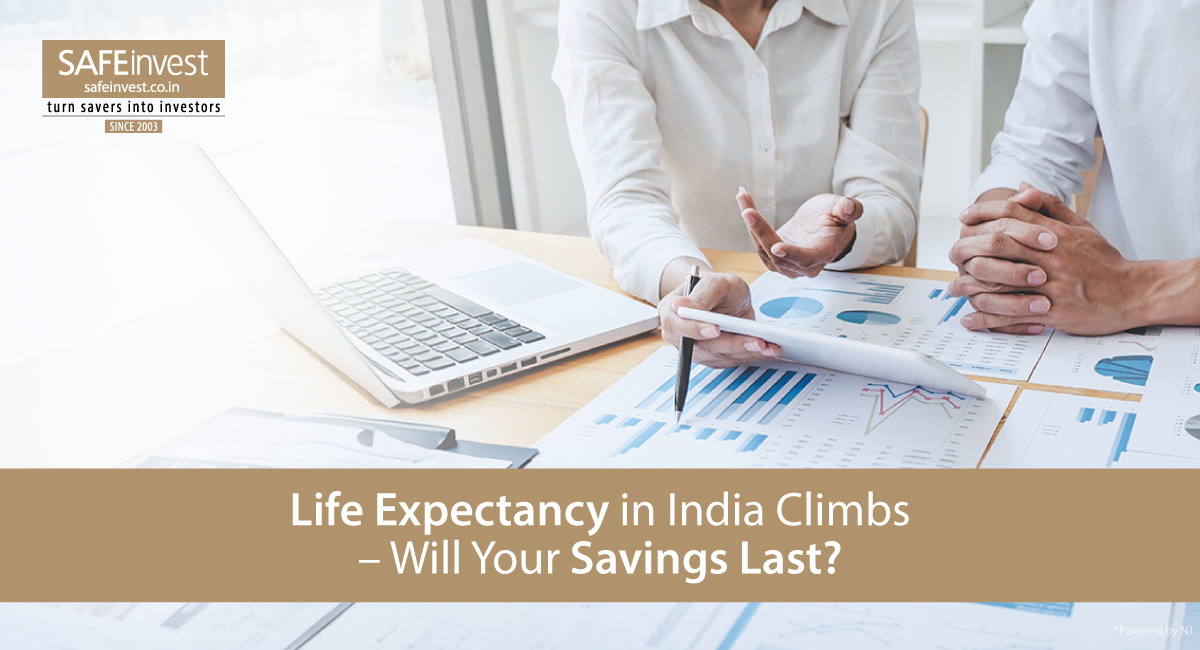Life Expectancy in India Climbs – Will Your Savings Last?

A WALK DOWN MEMORY LANE
Picture this. In the 1980s, your grandfather probably retired at 58, collected his pension, and lived another 10-12 years. Life was simpler, shorter, and retirement planning wasn’t rocket science.
Fast forward to today, if you are 30-40, chances are you’ll live till 80-85. That’s an extra 20-25 years of life after retirement. Sounds like a blessing, right? But it also comes with the big question: Do you have enough money to enjoy this longer ride?
THE SILENT REVOLUTION: INDIANS ARE LIVING LONGER
Here’s a wake-up call: in 2000, the average Indian lived about 62 years. By 2023, that number has climbed to 72 years (World Bank). That’s a 10-year bonus in just two decades, faster than many developed countries.
Source: https://data.worldbank.org/indicator/SP.DYN.LE00.IN?locations=IN
And it’s not uniform; if you are in Kerala, you may touch 78 years, while in Uttar Pradesh, it's closer to 69 years (MoSPI data). Women? They usually outlive men by 3-4 years. So yes, your spouse may need to stretch her retirement savings longer than you do.
Source: Mospi.gov.in
THE RETIREMENT PUZZLE
Living longer is amazing, but more years mean more expenses. It’s a whole new life chapter.
Think about it:
- Retire at 60, Live till 85: That’s 25 years without a paycheck.
- With inflation, your monthly expense of ₹50,000 today may become ₹1 lakh+ in 20 years.
- Healthcare costs? They’ve been rising at nearly 12-15% annually in India (IRDAI reports).
- While a longer life is great, a longer retirement is expensive.
WHY PENSIONS & SAVINGS ALONE WON’T WORK
Your parent or grandparents may have relied on pensions. But today:
- Shrinking Coverage:
- Less than 12% of India’s workforce is covered by any formal pension or retirement benefit (OECD, 2023).
Source: https://www.oecd.org/en/publications/pensions-at-a-glance-asia-pacific-2024_d4146d12-en/full-report/india_4bce689c.html
With 80–85% of people in the private sector, most Indians won’t receive any post-retirement income unless they create it themselves.
- Less than 12% of India’s workforce is covered by any formal pension or retirement benefit (OECD, 2023).
- Inflation eats Fixed Incomes:
- Even if you receive a pension, most traditional pensions are not inflation-linked.
A pension of ₹30,000/month today will buy only Rs 12,000 worth of goods in 20 years (assuming 6% inflation). - Most savings accounts in India earn 2.5-3.0% interest per annum, depending on the bank and balance slab. (TOI)
Source: https://timesofindia.indiatimes.com/business/financial-literacy/savings/top-banks-cut-savings-account-rates-after-rbi-rate-cut-decision-sbi-drops-to-2-5-hdfc-and-icici-now-at-2-75/articleshow/121932897.cms
- Even if you receive a pension, most traditional pensions are not inflation-linked.
- Rising Healthcare Costs Wipe out Fixed Benefits:
- With medical inflation at 12-14%, healthcare alone can drain most of a pension.
Example: If you rely on a Rs 25,000 pension, one hospitalisation could wipe out several months’ income.
- With medical inflation at 12-14%, healthcare alone can drain most of a pension.
- Private sector Employees are at great Risk:
- There are very few private companies in India that provide pensions.
At best, employees get EPF or gratuity, which is rarely enough to last decades without additional investments.
- There are very few private companies in India that provide pensions.
CRAFTING A RETIREMENT BASKET
As pensions alone cannot take care of you in retirement, you should take care of your own retirement planning. Here’s how:
- Build Personal Retirement Funds: Instead of relying on one source, combine multiple income streams like SIPs in mutual funds, NPS, PPF, and retirement-focused funds.
- Diversify Your Investment Mix: A mistake many retirees make is keeping all their money in a single asset class. While these feel safe, they rarely beat inflation. A balanced investment mix ensures growth and stability.
- Plan for Healthcare: Healthcare is one of the biggest financial shocks in retirement. In the coming years, Medical inflation in India can triple in 15 years.
- Buy Health Insurance Early: Premiums are cheaper in your 30s/40s than in your 50s/60s.
- Super Top-Up Plans: An Affordable way to increase coverage beyond your base policy.
- Medical Buffer Fund: Keep at least 1-2 years’ worth of expenses in liquid assets to handle emergencies without disturbing long-term investments.
- Work Longer, Work Smarter: Retirement doesn't have to mean stopping work entirely. Many professionals are now opting for "phased retirement," which allows them to continue earning without the demands of a full-time position.
- Consulting: Use your experience to guide younger professionals.
- Freelancing/Part-Time Roles: Work on your own terms while keeping income flowing.
- Hobbies to Side-Income: Writing, baking, teaching, or crafts can generate both purpose and money.
CONCLUSION: A LONGER LIFE DESERVES A SMARTER PLAN
India has gained 10 extra years of life in just two decades, and healthcare advances may push it even higher in the coming years. This is good news, but only if you prepare for it. Your retirement could last as long as your working career. That means what you save in your 30s and 40s decides how you’ll live in your 70s and 80s.
Don’t treat retirement as a distant worry. Start treating it as your biggest financial project. Build it with discipline, diversify it with care, and protect it with a comprehensive protection plan.
Because living longer should be a reward, not a financial burden.
“Life Expectancy in India Has Risen by 10 Years.
